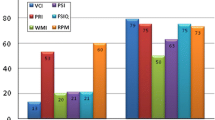Abstract
This paper discusses the advantages and disadvantages of using the Leiter International Performance Scale with autistic children and presents the results of a study comparing the performance of 18 autistic children on the Wechsler Intelligence Scale for Children-Revised and the Leiter. The results showed a high positive correlation between the WISC-R full scale IQ, the WISC-R performance IQ, and the Leiter IQ. There was no significant difference between the mean Leiter IQ and the mean WISC-R performance scale IQ, but there was a significant difference between the mean Leiter IQ and the mean WISC-R full scale IQ. There was a low correlation between the WISC-R verbal IQ and the Leiter IQ, and the means were significantly different. Reading attainment scores correlated positively with both the WISC-R IQ and the Leiter IQ.
Similar content being viewed by others
References
Alper, A. E., (1958). A comparison of the WISC and the Arthur adaptation of the Leiter International Performance Scale with mental defectives.American Journal of Mental Deficiency, 63, 312–316.
Alpern, G. D. (1967). Measurement of “untestable” autistic children.Journal of Abnormal Psychology, 72, 478–486.
Anastasi, A. (1982).Psychological testing (5th ed.). New York: Macmillan.
Bessent, T. E. (1950). A note on the validity of the Leiter International Performance Scale.Journal of Consulting Psychology, 14, 234.
Beverly, L., & Bensberg, G. (1952). A comparison of the Leiter, the Cornell-Coxe and Stanford-Binet with mental defectives.American Journal of Mental Deficiency, 57, 89–91.
Brask, B. H. (1972). A prevalence investigation of childhood psychoses. InNordic symposium on the care of psychotic children. Oslo: Barnepsykiatrist Forening.
Daniels, J. C., & Diack, H. (1958).The standard reading tests. London: Chatto & Windus.
DeMyer, M. K. (1976). Motor, perceptual-motor and intellectual disabilities of autistic children. In L. Wing (Ed.),Early childhood autism: Clinical, eduational and social aspects. New York: Pergamon Press.
Gallagher, J. J., Benoit, E. P., & Boyd, H. F. (1956). Measures of intelligence in brain-damaged children.Journal of Clinical Psychology, 12, 69–12.
Leiter, R. G. (1980).Leiter International Performance Scale, instruction manual. Chicago: Stoelting.
Lockyer, L., & Rutter, M. (1970). A fifteen year follow-up study of infantile psychosis: Patterns of cognitive ability.British Journal of Social and Clinical Psychology, 9, 152–163.
Maltz, A. (1981). Comparison of cognitive deficits among autistic and retarded children on the Arthur adaptation of the Leiter International Performance Scales.Journal of Autism and Developmental Disorders, 11, 413–426.
Orgel, A. R., & Dreger, A. M. (1955). A comparative study of the Arthur-Leiter and Stanford-Binet intelligence scales.Journal of Genetic Psychology, 86, 359–365.
Schopler, E., Andrews, C. E., & Strupp, K. (1979). Do autistic children come from uppermiddle-class parents?Journal of Autism and Developmental Disorders, 9, 139–152.
Sharp, H. C. (1957). A comparison of slow learners' scores on three individual intelligence scales.Journal of Clinical Psychology, 13, 372–374.
Sharp, H. C. (1958). A note on the reliability of the Leiter International Performance Scale-1948 revision.Journal of Consulting Psychology, 22, 320.
Stutsman, R. (1931).Merrill-Palmer scale of mental tests. New York: Harcourt, Brace and World.
Wechsler, D. (1976).Wechsler Intelligence Scale for Children: Revised manual. Windsor, England: N.F.E.R. Publishing Company.
Werner, E. (1965). Review of the Arthur adaptation of the Leiter International Performance Scale. In O. K. Buros (Ed.),The Sixth Mental Measurements Year Book (pp. 814–816). Highland Park, New Jersey: Gryphon Press.
Wing, L. (1980). Childhood autism and social class: A question of selection?British Journal of Psychiatry, 137, 410–417.
Author information
Authors and Affiliations
Additional information
We are grateful to the head teacher, staff, and pupils of the Sybil Elgar School for Autistic Children for their cooperation in the study.
Rights and permissions
About this article
Cite this article
Shah, A., Holmes, N. Brief report: The use of the Leiter International Performance Scale with autistic children. J Autism Dev Disord 15, 195–203 (1985). https://doi.org/10.1007/BF01531605
Issue Date:
DOI: https://doi.org/10.1007/BF01531605




